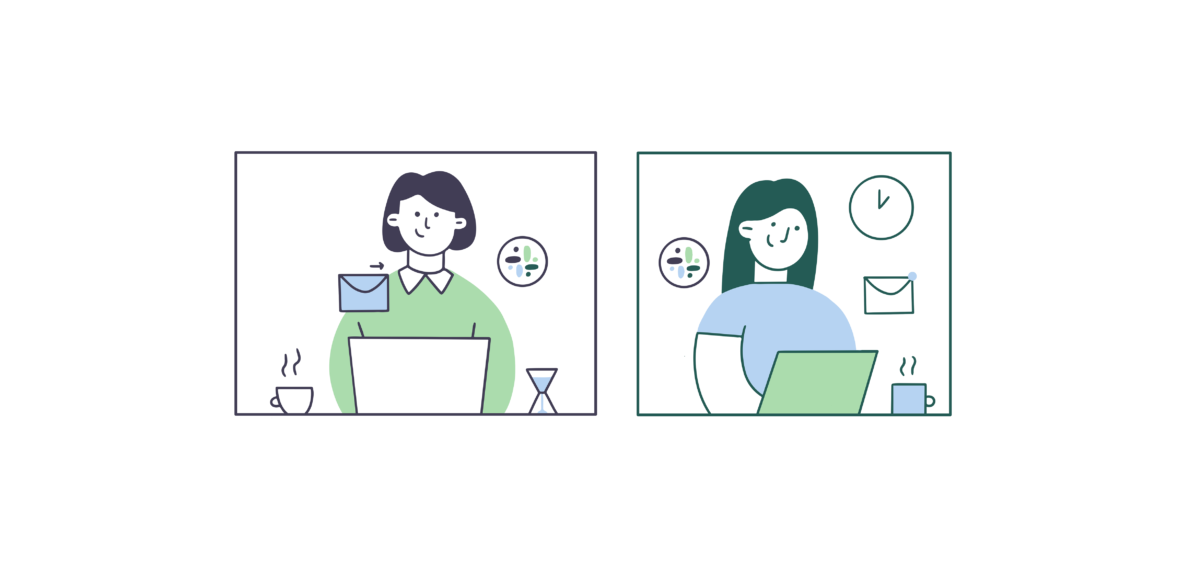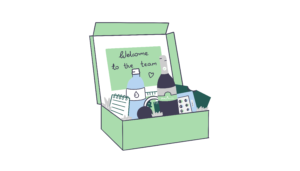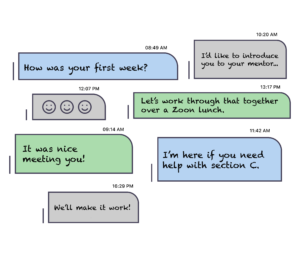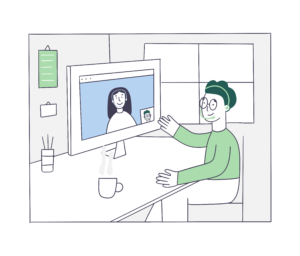A Guide to Remote Onboarding
A Guide to Remote Onboarding
From onsite to fully remote

You’ve hired remotely, now it’s time to think about designing a fully remote onboarding experience for your new team member.
Through a well-organised onboarding, you have the opportunity to increase a team member’s likelihood to stay and this is important considering it takes 6–9 months’ salary on average to replace an employee (StaffBase). Onboarding programs are designed to set the new employee up for success by educating on company culture, way of work (procedures, systems, workflows) and basic skills and extends further to include assigning of first projects and creating a social connection with the new team.
Overall the experience should show that you’ve put time and effort into making the employees first weeks and months exciting. Putting in the time makes the employee feel valued and is a big plus for both employee retention and productivity as studies show that employees increase their work efforts by about 20% when they’re subjected to an effective staff onboarding program.
This article will give you practical tips on designing a fully remote and people first onboarding process.
Remote onboarding during the Crisis
During COVID-19, even seasoned remote workers may find themselves in a less than ideal environment for learning or working. For those that rely on shared workspaces and childcare centres that are now closed or normally work in an office, impromptu home setups have become the norm and come with a new set of challenges.
While preparing an onboarding process during the pandemic ensure that you give space for your new starter to speak about any challenges they may have and adapt your program to assist. It is also important to give your new starter a view of what work-life will be after COVID, i.e. will they be returning to an office or will they experience different working hours.
Moving onboarding from onsite to fully remote
Remote workers aren’t naturally exposed to the energy and culture of the office environment and won’t have the face-to-face mentorship those onsite employees do. These challenges force us to become more organised in our programming, more creative in the ways we present learnings and more proactive in the way we instil community and collaboration.
- Tech that connects: Ensure everyone can connect remotely by getting your cloud-based tech tools for communication, learning and collaboration right. Gitlab recommends keeping this simple and start with programs like G-Suite, Slack, Zoom and your preferred onboarding tools. Ensure staff are comfortable and clued in on new communication norms.
- Community and Collaboration: Those impromptu ‘watercooler’ moments of conversation that onsite employees experience won’t exist for remote workers. Social moments are just as important as the professional ones. Social meetings that encourage bonding must be scheduled in a much more deliberate way to ensure remote workers are integrated properly.
- Take a documentation first approach: Well documented and easily accessible information is beneficial for all companies no matter the setup. For remote teams, this becomes more important. Consider an online handbook or Drive where all company documentation is stored and accessible during onboarding. Employees can depend on this for answers promoting a problem solving self-directed mindset.
How Long, How Short?
Onboarding should always begin before the new employee’s start date. An employee’s first touchpoint with the company begins during the hiring process and following a successful placement, communication lines should remain open to ensure a smooth evolution from candidate to employee.
The onboarding process can last anywhere from one week up to a year. Experts say that it takes up to 8 months for a staff member to fully settled into a new role.
Tip: Orange Quarter asks new starters to fill out a questionnaire before starting. We include general questions about their goals and where they’re from so we can create an introduction email but we also sneak in some questions about their favourite office snacks so we can have them sent in their swag bag.
Preparation & Programming
Onboarding should be approached with “general items” that all new employees should complete and then “department items” that are specific to a certain team or department. This is an easy and modular way to ensure onboarding is individualised to the requirements of the new starter. Most online onboarding tools will allow you to do this.
- Keep onboarding simple – don’t overcomplicate the program and only include learning items that are relevant to the new starter.
- Make the entire team aware of the starter and their role in the company. You may want to start a welcome thread on Slack and send out an email with some facts about the new starter on or before their first day.
- Foundation items could include; Read articles or listen to podcasts that describe your company’s values, read your company’s general documentation, gain access to all general software and cloud accounts used internally (e.g. Google Drive or Slack).
- Department items for a Software Engineer could include; Set up a meeting to get introduced to the code base, gain access to the company’s GitHub account, schedule pair programming call with a senior developer.
- Ensure to have all equipment, physical handbooks and swag packs delivered before their first day.

Onboarding should be individualized to the requirements of the new starter. Onboarding platforms like Eloomi and Personio allow you to easily customise onboarding using a modular approach.
Make a good first day impression
You only get one chance to make a good first impression and studies show it is extremely important to get it right for employee retention. Being well organised is a sure-fire way to make a great first impression so consider the below…
- Educate about the organisation and culture by giving the employee a birdseye view of the organisation and how it works.
- Give a good overview of what the onboarding program will include and the roadmap toward a successful completion. A checklist is a good way to provide an overview of the program and gives the new hire small, incremental goals while giving the feeling of progress. Note: A new hire checklist is simply a starting point, onboarding includes everything from those initial introductions to the first big project they work on independently and beyond.
- Provide a first-day meeting agenda and basic training on all core tools for remote communication.
- Pair your new starter with a mentor, someone senior that is not a direct manager. Mentors become a necessary supportive figure for remote workers that have distance barriers making it more difficult for them to connect with a team.
- Ensure the new team member is introduced to their direct team and other collaborators.
Optimise for Engagement
You know exactly what your new team members need to learn, now it’s time to think about optimising the presentation. Onboarding should be designed to maximise engagement and information retention while also creating a great candidate experience. Consider the following when designing your program.
- Participants want to actively be involved with the process. Ensure your program isn’t only reading, listening theory and models. Encourage participants to ask questions, solve problems and to actively participate by contributing their own experiences.
- Studies show that viewers retain up to 95 percent of a message delivered through video, compared to only 10 percent of what they read (WordStream) confirming that video should eventually become part of your onboarding process.
- Encourage activities that let co-workers interact with each other, give and receive feedback and share ideas and content. You could ask the new starter to collaborate with members of their team to solve problems in their training. If there are employees going through onboarding together, you could encourage them to problem-solve together. Include scheduled video chats with team members and encourage social interaction as part of the learning.
- Adding game-like elements (Gamification) is proven to boost engagement. Onboarding platforms like Eloomi have Gamification features to guarantee increased motivation, engagement and attention to detail.
- A report by Software Advice shows that 50% of employees are more engaged by taking microlearning courses. Microlearning modules of 3-7 minutes matches the working memory capacity meaning the information becomes more digestible and sticks better.
Most onboarding platforms will allow you to measure and track results. It is important to take note of this throughout the process and use them as a reference point for regularly scheduled check-ins with the new starters.
Create a remote culture of connection
Fostering a positive team culture is a big deal when it comes to employee retention and ensuring you’re able to integrate remote employees into that culture should be a priority during onboarding. Informal chats and get-to-know-you sessions all help to build a strong working relationship. Rapport building helps people feel closer to their team and will improve performance and decrease displacement.
- Be deliberate about scheduling social activities within the onboarding process to allow the new team member to connect with colleagues. This won’t happen organically like it would in an onsite setting. Considering virtual coffee dates and get-to-know challenges.
- Reduce the tendency for remote workers to feel isolated or unsupported. You can do this by ensuring that they know who their support contacts are and with regularly scheduled meetings.
- Ask for feedback during and after the main parts of the onboarding. Questions can include ‘What parts of the onboarding process helped you understand our team better?’ and ‘Were there any parts you found challenging, did you have the support you needed to overcome it?’.

Find ways to share and celebrate successes online. A mention during a group video call goes a long way but you could also get creative with automated Slack messaging and delivering gifts.
5 Interesting Ideas from companies doing remote onboarding well
Culture Buddies at Buffer
Buffer assigns both a mentor and a culture buddy to the new hire. The culture buddy is typically on a different team and selected to help guide the new hire through culture-related discussions and provide additional context on company history and norms. This buddy will chat weekly with the new hire for the first six weeks and normally becomes friends throughout the process.
GitLab CEO Meet
Gitlab are famous for their fully remote business model and have a streamlined remote onboarding process as well. Gitlab pre-organise a slot with the CEO each month that new starters join and prepare questions for.
Google ‘Just in time’ email
At Google, just one day before a new hire joins, the hiring manager is sent an email with five small tasks that will need their attention. Creating a sense of urgency and responsibility for managers improved onboarding results by 25% at Google.
Doist Mentor Trips
Doist arranges Mentor Trips where a new teammate flies to meet their mentor in a different city and works with them in person for a week. This can expedite and ease the learning process and strengthen the bond between mentors and mentees.
Lunch Roulette at Warby Parker
To increase social interaction within the first weeks, a developer at Warby Parker created “lunch roulette.” An app that randomly selects eight people from within the organization every week to have lunch with the new starter. An initiative easily managed remotely through a Zoom call

Wrap it up
Onboarding is as much about skills development and practical knowledge as it is about building stronger social connections with the team to foster a culture of belonging. Onboarding is essential in giving new hires the support and confidence they need to thrive within the company.
Combining thoughtful hiring and intentional onboarding ensures employees establish an intrinsic connection with the company boosting collaboration and commitment from any location in the world.